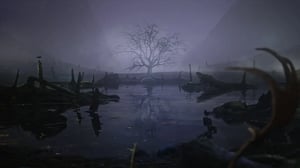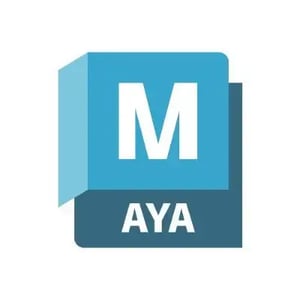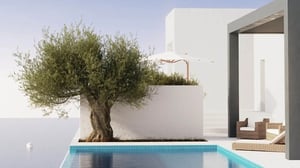
Virtual Production Real-time 3D Artist - Film
Student work by Marc Carratala & Benjamin Oman
TABLE OF CONTENTS
What does a film real-time 3D artist do?
Real-time artists create interactive 3D content and assets that are rendered in real-time. They often work on a project from concept to completion, collaborating with filmmakers to realize a broader vision. Real-time artists are also responsible for maintaining visuals in both quality and optimization—from entire environments down to small 3D props, known as assets. real-time artists also add lighting, and create textures.
Real-time 3D artists are often generalists who collaborate with other artists, designers, and programmers to realize a broader vision, commonly known as virtual production.

MarcCarratalaArce-UnrealEngine
Still from Marc Carratala's short film, 'Frozen Lands' created in Unreal Engine 4 as part of the Virtual Production Course at CGS
What is virtual production?
Virtual production is analogous to traditional production. The main difference is that renders occur in real-time. Real-time is paving new, improved workflows for the film industry and bridging some gaps in the traditional production pipeline, allowing real-world and digital platforms to converge. It’s been adopted as a tool by filmmakers and content creators to visualize what they’d usually only be able to view in post-production at the pre-production and production stages.
Marc's latest captivating short film using Unreal Engine 5, 'Dark Nebula', inspired by Ridley Scott's Alien. Marc worked on all aspects of the production — from concept, script, and direction to world building, animation, and cameras — as part of the Real-time 3D & Virtual Production Course at CG Spectrum.
The LED volume is possibly the most recognized use of virtual production methods. A wall of LEDs (light-emitting diodes) display a real-time rendered 3D virtual environment that curves around physical sets, actors, and props. Through live camera tracking, the virtual camera within the game engine moves to match the physical on-set camera, shifting what’s displayed on the LED wall, like a shift in perspective. This synchrony between camera and imagery creates parallax, helping to create the illusion that the real and virtual elements reside in the same space. Lucasfilm’s The Mandalorian is a well-known example of a production that used virtual production on set.
Film real-time artist job description
Real-time artists focus on content or asset creation in a real-time environment such as a game engine, often working on a project from concept to completion. They are also responsible for maintaining visuals in both quality and optimization — from entire environments down to small 3D props, known as assets.
Role & responsibilities of a real-time artist in virtual production for film and TV:
- Mockup concepts and adjust as directed
- Work with the Director and Real-time team to design interactive experiences using a game engine
- World building (create and layout assets in a real-time engine)
- Light scenes for a better cinematic experience
- Optimize content through profiling and enhancing performance with the help of diagnostic tools
- Collaborate with programmers to develop and test new features, prototype shader code, and provide useful feedback during R&D phases.

How much does a commercial real-time artist make?
The national average salary of a Real-time 3D Artist is $72,980 annually in the United States. (Source: salary.com)
Skills required to become a film real-time artist
When starting in this competitive field, you’ll need to focus on learning technical tools and be proficient in a game engine such as Unreal or Unity, which often also involves some coding.
Film studios may look for the following skills in a real-time artist for film:
- Experience in a real-time engine
- Real-time ready asset creation (props, characters, etc.)
- Texture/Shader knowledge
- An understanding of animation, animation rigs, and anatomy
- Scripting languages like MEL, Python, C#, and Javascript are useful
- A general understanding of cameras and how changing their values will contribute to how you might block, light, and shoot a scene.
- Basic knowledge of film production processes (e.g., scripts, concepts, sets, storyboards) and the production pipeline.
What software and tools do real-time 3D artists use?
When starting out in this competitive field, you’ll need to focus on learning a real-time game engine, but the importance of art fundamentals cannot be underestimated. However, because real-time artists often take on a more generalist role, there’s plenty of other software that’s worth learning too.
Real-time artists may need knowledge of a combination of the following software:

Maya is a comprehensive 3D animation software used for creating detailed models, animations, and visual effects. It's popular in film, TV, and game development for its powerful tools.

MotionBuilder is a 3D character animation software produced by Autodesk. It is used for virtual cinematography, motion capture, and traditional keyframe animation.

Unreal Engine is a 3D computer graphics game engine developed by Epic Games, first showcased in the 1998 first-person shooter video game Unreal

Substance Painter: The tools you need to texture your 3D assets, from advanced brushes to Smart Materials.

Houdini is built from the ground up to be a procedural system that empowers artists to work freely, create multiple iterations and rapidly share workflows with colleagues.

Unity is a cross-platform game engine developed by Unity Technologies, first announced and released in June 2005 at Apple Worldwide Developers Conference
How to become a real-time 3D artist
“Using Unreal Engine is a perfect way to onboard people into virtual production as the ability to be physically accurate with settings and values is built-in to many parts of the software and allows for a natural transition into the virtual world." -Deepak Chetty, Filmmaker and CG Spectrum Virtual Production mentor
Download a game engine
Download and familiarize yourself with a free game engine like Unreal Engine.
Build skills
Build skills companies are listing on job sites. For additional support, enroll in a reputable course. CG Spectrum’s courses include mentorship from real-time pros and an industry-led curriculum.
Stay ahead of trends
Online tutorials, webinars, and publications can help you stay up-to-date on trends and keep your skills fresh.
Create real-time content
Creating content in a game engine will teach you relevant tools while building your portfolio. Upload finished work to a visual platform, like ArtStation, to showcase to potential recruiters and to view your progress.
Sell assets online
Create and sell assets on Unreal Engine Marketplace, or similar, to gain exposure, get constructive feedback from real-life users, demonstrate skills to potential employers and collaborators, and make money!
Join competitions and game jams
Practice your skills and create content for your portfolio by participating in game jams (e.g. Epic MegaJam, itch.io/jams), or starting one with friends. The Rookies also host contests.
Engage with communities
Networking is vital. Interact with industry pros who might offer advice, insights, or job opportunities. Join the Epic Developer Community and see our resources section for more.
Collaborate with peers
Know an animator who’d love to add their character performance to a 3D environment? Perhaps a friend wants to help you build a virtual world! Collaborating with peers is fun and can produce more polished portfolio pieces.
Internship
Internships at studios specializing in real-time, can help you break into the industry. It’s not viable for everyone but can be a way to gain hands-on experience while networking and experiencing studio life.

Ready to Start Your Film & Games Journey?
Download our course guide to see how we can help you on your pathway to your dream career.Tips to break into the real-time 3D industry
Here are some additional resources to help you get ahead as a real-time 3D artist working in virtual production.
- Read What is Virtual Production?
- Watch How to become a real-time 3D artist
- Subscribe to William Faucher’s YouTube channel
- Explore Unreal Engine’s free courses
- Build 3D worlds using free assets from Unreal Engine Marketplace
- Explore Virtual Production Career Pathways
- Join the Epic Games Dev Community
- Join the Virtual Production and the Unreal Engine: Virtual Production Facebook groups
- Watch the ‘Unreal Build: Virtual Production’ replay
- Explore ArtStation’s Unreal Engine channel
- Review the Visual Effects Society’s virtual production resources
- Check out Game Jam Tips and Tricks from Epic Games’ developers
- Learn how to use Houdini with Unreal Engine and with Unity
- Epic Games’ Virtual Production Field Guides: Volume 1 and Volume 2

Industry Pathways
Welcome to our brand new series, Industry Paths. Tune in to meet our professional mentors from across the film, games, and visualization industries and hear directly from them about how they got started, what a day in their life looks like, and why they do what they do.
In this episode, you'll hear from Nicklas Byriel, CG Spectrum's Department Head of 3D Visualization.


